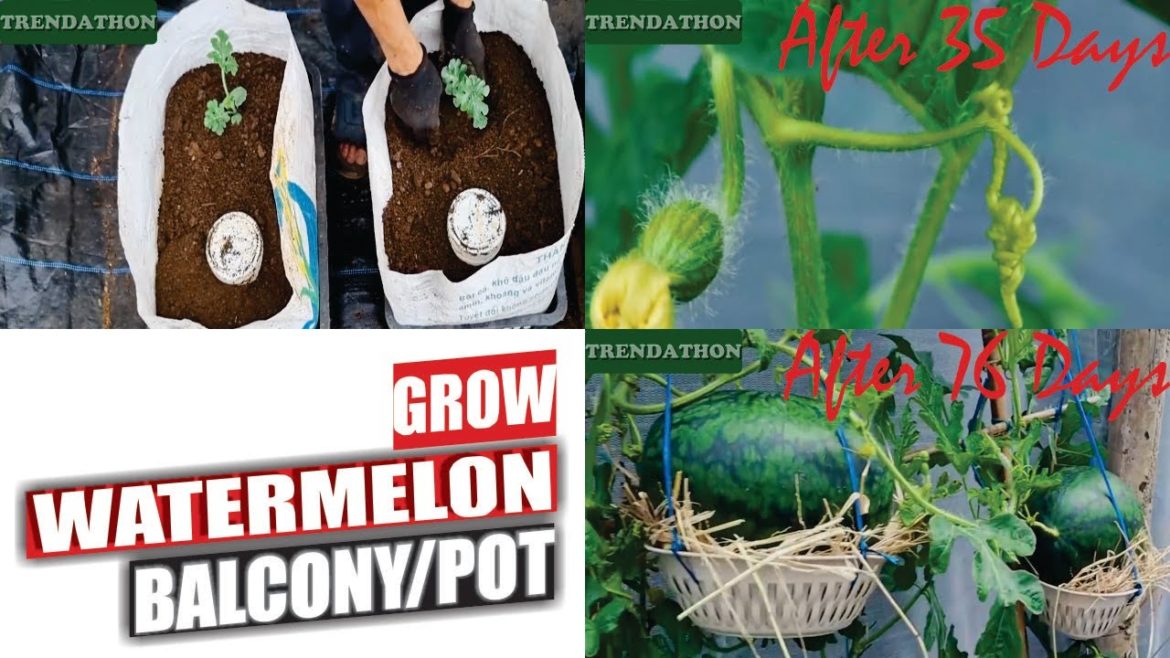Welcome to Trendathon, Ladies and Gentlemen!
The 9 Watermelon Growing Stages: A Complete Guide
Growing watermelons isn’t too difficult, and much of it depends on the climate and weather conditions.
Before we get carried away by the details, let’s look into some basic specifics about watermelon plants:
Scientific name: Citrullus lanatus
Native habitat: Africa
Ripening time: 70-90 days after planting
Fruit size: Cultivated varieties may be over 2 feet (60 cm) long
Vine size: Average vines spread up to 10 feet (3 m), but some can be 12-15 feet (3.6-4.5 m) long
Here are some tips that can help you with planting watermelons and adjusting the soil to its needs:
1. Planting
If you live in a warm climate, you have more options and you won’t have to plant watermelon seeds in early spring as there’ll be more warm days.
If you live in a colder climate, you should start your watermelon seeds indoors approximately four weeks before the last frost date, and then transplant them when the soil temperature reaches at least 70°F (21°C).
Plant the seeds an inch (2.5 cm) deep and approximately six feet (1.8 m) apart, which will give them the space they need to grow and spread or use trellises to plant them vertically.
Finally, ensure that the planting medium is loamy and well-draining and that the place you chose for your watermelon gets 8-12 hours of sunlight. Water the seeds thoroughly.
2. Seed Germination
The first growing stage is seed germination, and it begins as soon as you cover the seed with soil. However, if you plant the watermelon seeds in a medium with a temperature lower than 65 degrees Fahrenheit (18°C), they won’t germinate, so you need to be careful about that.
3. Sprouting
After the seeds have germinated, you’ll notice sprouts, the first two leaves which are commonly known as embryonic leaves.
4. Vegetative Growth
The vine usually grows to about 12 feet (3.6 m) long, and one month after planting you’ll notice new vines.
5. Branching
The appearance of new vines is known as branching, and you don’t necessarily have to remove them. However, you should give additional nutrients to your watermelon, and adding half a cup (120 ml) of bone meal to the soil might be just what it needs.
The vines and leaves will continue to grow until your plant starts flowering.
6. Production of Flowers and Pollination
Male flowers are the first to appear, but female flowers soon follow, and pollination can then begin. Male flowers contain pollen that is transferred onto the female ova, and if the pollination is successful the fruit sets.
7. The Setting of Fruit
Once the fruit starts growing, you can fertilize your plant with a low-nitrogen fertilizer such as 5-10-10. At this stage, you’ll also want to reduce watering to an inch of water (2.5 cm) a week, as you don’t want the fruit to get a watery taste.
8. Harvesting
It takes about a month for the fruit to mature, but there are some signs of ripeness that can help you know when to harvest watermelons.
9. Drying
Everything has its end, and so does a watermelon’s life cycle. After harvesting, watermelon vines begin to dry and die out.
How Long Does It Take to Grow Watermelons?
It takes about three months for a watermelon to fully mature, but it depends on the variety; some watermelons need four months to ripen.
Light Requirements
Watermelons need full sun to thrive, and that means at least six hours of sunlight each day. Plant the watermelon somewhere it can get enough sunlight in the morning and be protected from the afternoon sun.
Soil And Fertilizer
Watermelons prefer mildly acidic to neutral soil with a pH between 6.0-7.0. The substrate should be well-draining and rich in nutrients and organic material, so adding some compost before planting is highly recommended.
Fertilizer
Watermelons benefit from additional nutrients provided by fertilization, so you should use well-balanced, nitrogen-rich fertilizers such as triple 10 during its vegetative growth stage.
However, once the flowers appear and the fruit starts to grow, reduce nitrogen as it will only delay flowering and lead to a smaller yield. Fertilizer such as 5-10-10 is rich in phosphorus and potassium, which are extremely important for flower and fruit development.
Pruning
Pruning is not something you should be afraid of. In fact, it even promotes healthier growth and increases fruit size.
Pro tip: Prune the vines only when they are dry as moisture promotes the spread of infections and parasites.
Pests
Some of the most common pests that attack watermelons are aphids, thrips, spider mites, cucumber beetles, and cabbage loopers.
Luckily, most of them can be killed with insecticidal soaps. If the infestations aren’t too wide-spread, you can simply pick them off one by one or introduce their natural enemies, such as ladybugs for aphids or soldier beetles for cucumber beetles.
#watermelon #growinpot #growinbalcony

